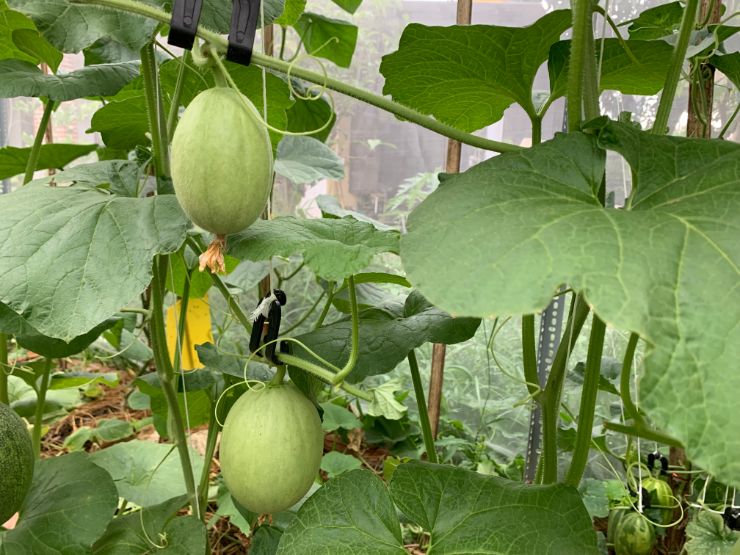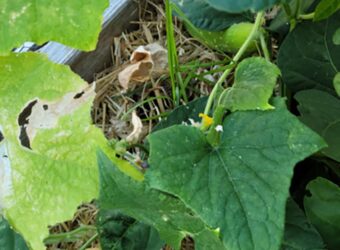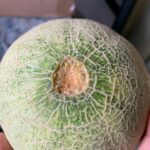Cantaloupe grows on sprawling vines that take up a lot of space in the garden. What does the plant go through between planting and harvest? Here is the answer.
Important Cantaloupe Facts
| Scientific Name | Cucumis melo var. cantalupensis |
| Type of plant | annual |
| Part Eaten | fruit |
| Days to Harvest | 70-100 days |
| Season Grown | Warm season |
| Cooked or raw | raw |
| Optimal pH | 7.0 |
| Germinate at | 65 F |
| Optimal Temperature for growth | Above 70 degrees F |
What we call cantaloupe is really a muskmelon. True cantaloupes are small and warty and not usually eaten in the United States. I will continue calling the muskmelon a cantaloupe since that is what everyone is used to referring to them as. Cantaloupes are annual fruits that grow on vines that can be three to four feet long. It takes about 70-100 days from germination to the first harvest, depending on what variety of cantaloupe you are growing. Cantaloupes are warm-season fruits and are easily damaged by frost.
The 6 Cantaloupe Growth Stages
| Growth Stage | Days after Planting For the Stage to Start* |
| Germination | 0 |
| Seedling | 10-12 |
| Vining | 15 if direct seeded, 30 if started inside and transplanted |
| Flowering and Fruit Set | 30-40 days from germination |
| Fruit Growth | 30-40 days from germination |
| Harvest | 70-100 days from germination |
*The exact time depends on the variety.
Starting Indoor or Out?
In colder regions, cantaloupe must be started inside and transplanted outside when the soil warms up in order to get a crop before the first freeze. In warmer regions, cantaloupes are generally seeded directly in the ground outside. In either case, it takes a cantaloupe about ten days to germinate.
To start seeds indoors, fill a seed tray with a soilless seed starting mix. Make sure it is thoroughly wet before planting the seeds in it. Plant cantaloupe seeds one inch deep in the seed starting mix. Space them one every three inches. Keep the seed starting mix moist but not soggy until the seeds germinate. I have found it helps to cover the tray with a clear plastic dome or with clear plastic wrap to maintain a high humidity while waiting for the seeds to germinate. Place the tray in a warm place with some light.
To start cantaloupe seeds outdoors, wait until the soil temperature is at least 65 F. Build a hill that is four to six inches high and about six inches in diameter. Space the hills three feet apart. Plant four to six seeds one inch deep on each hill. Keep the soil moist until the seeds sprout.
Let The Competition Begin
Seedlings start competing from the time they sprout, about ten days after they are planted. If starting the seeds indoors, remove the cover when you notice the tiny seedlings. They can stay in the tray until the time to transplant them when they are about 30 days old. When the seedlings have two true leaves, fertilize with a weak solution of fish emulsion once a week. Water from below to reduce fungal diseases.
If they are started outside, they need thinning. When the first true leaves form, pinch off the stems of all but the two strongest seedlings per hill at the ground. Do not pull them up, or the roots of the survivors will be damaged. Seeds started outdoors go to the next stage almost as soon as they are above ground, while seedlings started indoors stay in this stage until they are transplanted outdoors.
Growing Vines
Once seedlings are transplanted, or seeds planted outdoors have germinated and are about six inches long, the plant starts vining. It grows a long vine covered with foliage. Fertilize with 10-10-10 at two to three pounds of fertilizer per 60-70 feet of row now for good vine growth. A healthy vine is necessary to support the nutrient-rich fruit. You can allow the vine to grow along the ground or trellis it on a trellis or fence. The advantage of trellising the vine is that it takes less room in your garden. Fruit is also harder for ground-dwelling insects to attack, and the bottom of the fruit will be less likely to have a rotten spot where it sits on the ground.
Flowering and Fruit Set
About 30 to 45 days after germination, the cantaloupe plant will start flowering. At this stage, fertilize with 10-10-10 at two to three pounds of fertilizer per 60-70 feet of row. Flowers are pollinated by insects. Each female flower has the potential to produce a fruit, although not all flowers do. Male flowers form first, so you will notice flowers for a week or so before any set fruit. This is normal, so don’t panic. The female flowers start about a week later and continue until the vine is frozen.
Melons On the Vine
Cantaloupes take about 30-45 days to ripen from when the flower blooms. This is 70-100 days from germination. They take a lot of nutrients from the soil and require a lot of water to taste good. Make sure you keep the soil moist, or the melons will be bitter. Because the fruit takes a long time to ripen, it is vulnerable to pests and diseases. Keep an eye on the vine every day once the plant starts flowering so that you can catch problems early. I trellis my cantaloupe vines to save space. I use pantyhose to form a sling under each cantaloupe to support it as it grows. The pantyhose stretches as the melon grows but has enough support to keep it from tearing off the vine. It also helps protect the fruit from insects and rabbits. Other animals like cantaloupe as much as humans, so take steps to protect your cantaloupe from them, or you won’t get to eat it.
Harvesting Your Melons
A lot has been written about when to harvest cantaloupe. They do not get riper after picking, so it is important to allow them to ripen before you harvest them. On the other hand, they will rot in the field if left too long. Most people harvest cantaloupe when the webbing is gray, and the area between the webbing is yellowish orange. The area where the stem joins the cantaloupe should have a crack around it at least part of the way. If left on the vine too long, cantaloupe will fall off it. The sling catches them if that happens when trellised, so they do not splat when they hit the ground. Harvest in the morning before it gets hot so the cantaloupe will store the longest. Handle the fruit carefully, as it is fragile.
Storage Instructions
Cantaloupe should be stored in the refrigerator as soon as they are harvested. They last about a week in the refrigerator if harvested when the stems start cracking, and about 48-72 hours if they have slipped off the vine entirely before harvest. Cantaloupe does not freeze well and is not usually canned.
Collecting Seeds
Cantaloupes have seeds in the center of the melon. They are easy to scoop out. Wash them until all the pulp is off of them. Spread them on a paper towel until they are completely dry. Save them in an envelope or a glass jar in a cool, dry place. Do not freeze them.
In conclusion, cantaloupe goes through six stages of growth, from germination to harvest. The first cantaloupe should come off the vine 70-100 days after the seed germinates, depending on the variety. Cantaloupe vines will continue to produce cantaloupe until the vine freezes. Green cantaloupe will not ripen once taken off the vine, so it is important to let the cantaloupe ripen fully before harvesting it. They will last from three days to a week in the refrigerator. Cantaloupes are not suitable for long-term storage, so enjoy them when you get them.






